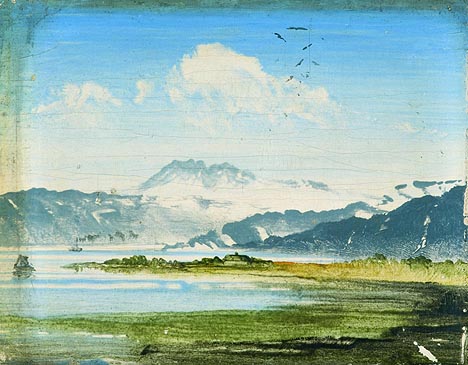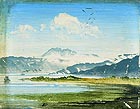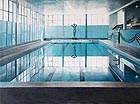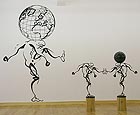
translated and summarized by: Liz Wollner-Grandville,
English summary November 10 - 16
Kunsthalle Krems: Peder Balke – Pioneer of Modernism
North Star with delayed visibility
40 landscape paintings by Peder Balke (1804-1887) fill the chic, but rather cool sky lit room in the Kunsthalle Krems. While his work is rather unknown to this part of the world, it nevertheless seems familiar. Didn’t the old masters compose their classic paintings in line with the three colour zones: brown front, green middle part, and blue as the depiction of distance. And didn’t numerous painters in the first half of the 19th century like Caspar David Friedrich, Johan Christian Clausen Dahl, Carl Rottmann, and William Turner leave their traces in Balke’s oeuvre? But then one stands in front of these landscapes, which one has never seen painted in this way before.
In 1847, King Louis-Phillipe bought two of his oil paintings and 26 drawings, all of which are now owned by the Louvre. But already during his lifetime Balke sank into oblivion. Balke had travelled extensively and visited important art centres such as Dresden, Munich, Paris, and London; and he even came to Vienna. But when Balke started to experiment with his technique, his Norwegian contemporaries, who by then favoured the style of the Dusseldorf school, not only found his work insufficiently contemporaneous but even considered him incapable of painting. Nevertheless, Balke remained a well-known figure in the public: as a social reformer. From that time on he only experimented within his own four walls.
Today, these experiments established his reputation as a “Pioneer of Modernism”. His romantic variations of the North Cape, once immersed in dramatic lighting or surrounded by cloudy skies, the masses of turbulent water, the loneliness of his landscapes, or people in lighthouses or on ships, make’s one curious to find out more about this North Star and his delayed visibility. His late 1850s landscape paintings are the “real” (re) discovery. They show the entire range of Balke’s remarkably modern handling of colour as material: colour wiped with bristle brushes, wet-in-wet painting, or the scraping off and telescoping of colour layers. Although his compositions were rather traditional, Balke took up the challenge offered by landscape painting and started his formal experiments. His work went far beyond the usual “viewing-limits” of his contemporaries; his work became nearly incomprehensible to them: the fate of modern artists per se.
Kunsthalle Krems
3500 Krems, Franz-Zeller-Platz 3, until 05.02.09
www.kunsthalle.at
Strabag Kunstforum: Strabag Artaward 08 – Markus Proschek – Deadlock (Patt)
Of skilful dealings with “empty” spaces and their history
The eerie but beautiful tidiness and emptiness immediately leap out at the observer when viewing the wonderful and technically perfect oil paintings by Markus Proschek (born 1981). His works never include the depiction of living creatures, only statues reminding of the 1930s and 40s Nazi-Realism. It seems as if only surrogates fill or precisely don’t fill the space, while only the space itself is of importance. Space filled with history or traces of history.
The works by the artist, who is definitely a worthy prize winner, allude to history in a meticulous manner. Ranging from a fragment reminding of a 1930 Merzbau (Merz Building) to a lounge-landscape of the 70s, one detects all kinds of familiar architecture. Spaces itself develops into the actual protagonist, since all of the figures, as far as there are any, are only static and part of the setting. These “idylls” are then skilfully deconstructed with minor, but disturbing variations. In one of his most remarkable works, Proschek shows a museum room located in the Haus der Kunst and built by the Nazis, where instead of the large centrally positioned painting, you will only find a blank area.
These paintings and their omissions force the onlooker to deal with these blank areas, these eliminated essentialities of art history. His works could be a starting point to grapple with the traces and continuities of so-called “Nazi art”. Proschek’s paintings make it clear that there is no such thing as empty rooms, every object communicates some form of history and meaning, and one should learn to face this history instead of simply denying its existence.
Strabag Kunstforum
1220 Vienna, Donau-City Strasse 9, until 28. 11. 08
www.strabag-kunstforum.at
Kunstraum Palais Porcia: Index. Signs of everyday life
In the sign of everyday life, but not everyday
Both the selection as well as the presentation of this exhibit is remarkable. Rarely do curators show so much sensitivity and courage showing only the most significant works. Many large paintings and spectacular objects were done without - this allowing for an outstandingly harmonious exhibit given this limited amount of available space.
The only works shown on canvas are Selim Birsel’s drawings. One of them, created in a similar style as Van Goghs early works, depicts an old man with a cap sitting on an equally old chair. Without any background motif or colour, this drawing still develops an enormous intensity, and, despite its huge format, it remains simple and unobtrusive.
Ceren Okyut painted his own fantasy world onto the walls of an otherwise empty room. His passion for detail and the fact that this painting can never be sold or even stored, turns his work into one of the highlights of the show. Okyut’s painting makes it very clear that art is not a professional business, but an attitude to life.
The small, backlit show cases with paper-cut scenes created by Nermin Er prove how convincing discovery and amazement, as well as the art of picture narration can be.
This exhibit is an absolute insider’s tip and definitely more worthwhile seeing than some of the large reviews of contemporary Turkish art.
Kunstraum Palais Porcia
1010 Vienna, Herrengasse 23, until 25. 11. 08
Kunsthalle und Kunstverein Düsseldorf: Reiner Ruthenbeck
Kinetic concept
Reiner Ruthenbeck’s works are currently shown in an unpretentious retrospective at the Kunsthalle Düsseldorf. As one of Josef Beuy’s first students he avoids any distastefulness in his objects and installations, and whoever thinks he might blunder, errs. However, by comparing the 14 folding tablets (1977) with Beuy’s Palazzo Regale (1985) a certain closeness to Beuys becomes apparent in a congenial way. The spatial balancing out of objects in both installations, and the concept of proportions form an imaginary “packing-the-suitcase-contest” between Beuys and Ruthenbeck and turn it into a game; a game, which would easily be won by both – something only possible in art.
The arrangement of the objects in the Kunsthalle cinema hall, characterized by its red upholstery, evokes an engaging aura of elegance. It is worth strolling from one work to the other following a given path. All of the works are positioned in such a way that the room sets off a kind of Dolby-Surround-Effect.
A cordon impedes the entrance to the gallery hall and thereby the scenery, which focuses on the appearance of tables with a sense of balance (Table with rubber rope 1983, Table on steel rods, 1983/84, Table on yellow orb 1984) reminds more of a peep box. The concept of a cinema with moving viewers tallies. Whoever thought that cinema does not take place in one’s head, can protest in the Austrian tabloid “Kronenzeitung”. Everyone else should travel to Düsseldorf and Duisburg, where Ruthenbeck’s earlier works are shown, or at least take a closer look at the catalogue, which is due to be published around the middle of November.
Kunsthalle und Kunstverein Düsseldorf
40213 Düsseldorf, Grabbeplatz 4, until 11.01.09
www.kunsthalle-duesseldorf.de
Wilhelm Lehmbruck Museum
47049 Duisburg, Friedrich-Wilhelm-Strasse 40, until 11.01.09
www.lehmbruckmuseum.de
Mehr Texte von translated and summarized by: Liz Wollner-Grandville


 Teilen
Teilen




